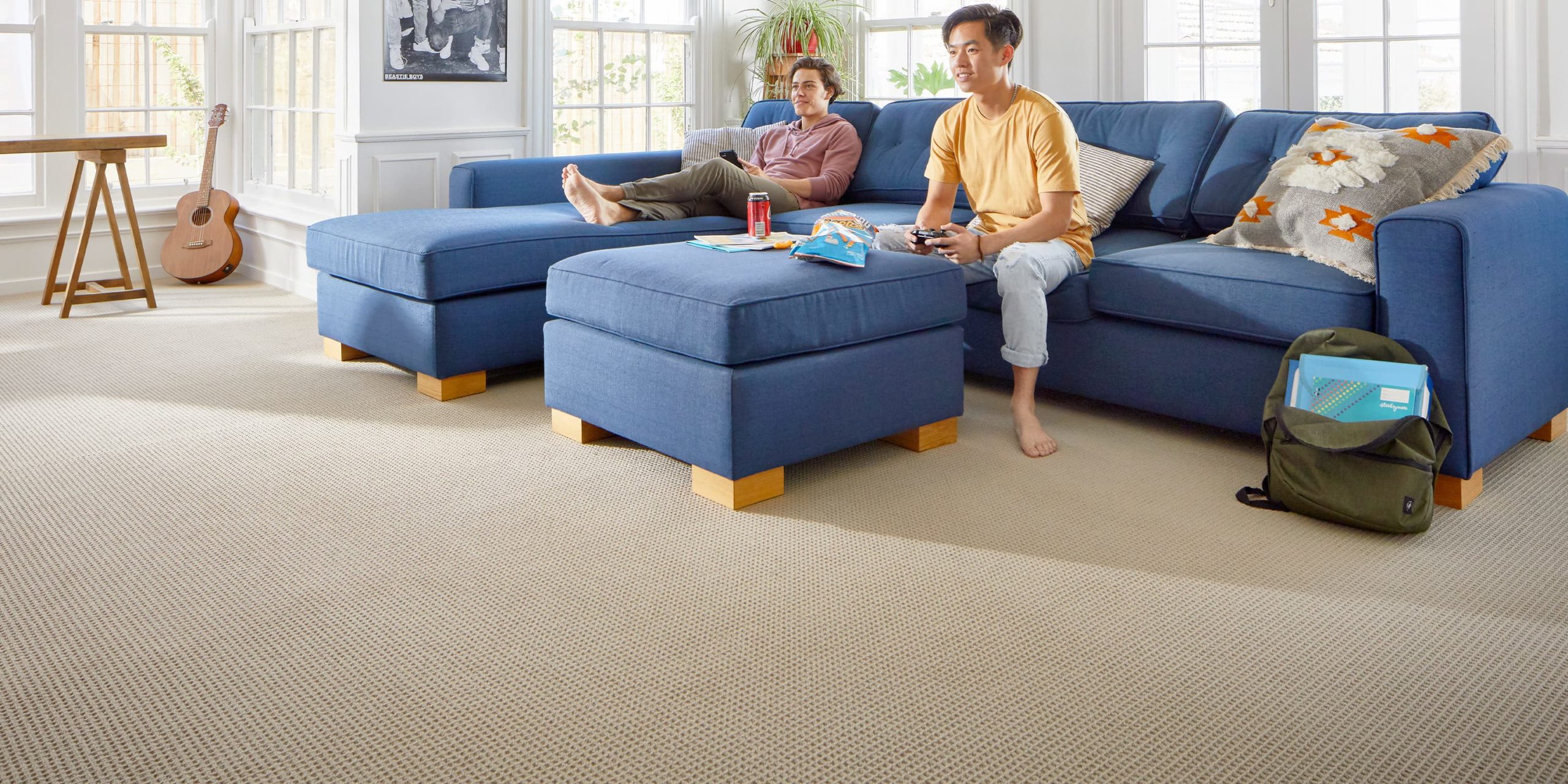

12 Jan Ultimate Guide to Polypropylene Carpet
There are many synthetic carpets available on the market today. One of the materials that have been consistently selling is polypropylene carpet, and for good reasons. You probably have a few questions about the pricing, installation, pros and cons, and how they hold up compared to other carpet types.
To arm yourself with the necessary knowledge, here’s our ultimate guide to shopping for polypropylene carpets.
What Is Polypropylene Carpet?
A polypropylene carpet is made out of synthetic materials. This means the fibres used are man-made and do not come from organic or natural sources like wool carpets.
Polypropylene fibres are a type of plastic derived from petroleum. The fibres are spun directly from polypropylene beads and then twisted, looped or left as stringy fibres. These are them tufted together on a latex or nylon backing to form carpets.
Aside from carpets or rugs, polypropylene is typically used in food packaging and medical devices as they are deemed safe according to the FDI.
This means polypropylene carpets are much more affordable than natural wool carpets, whilst keeping out the nasties typically associated with most synthetic materials. Furthermore, they offer the same beautiful and modern look that carpets can give.
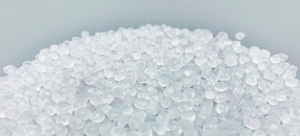

Advantages of Polypropylene Carpets
Polypropylene carpets are designed from the get-go to prioritise many great features that people come to expect. Here are the benefits in store for you:
1) Polypropylene Is Durable
One of the most well-known benefits of a polypropylene carpet is its high durability. They have a decent lifespan and can withstand a lot of messes, cleanups, pet scratches, and more. Their synthetic fibres are very hard to tear apart. Many people opt for polypropylene carpets because they know it will take years before they ever need a replacement.
2) Easy to Clean
Many people want a low-maintenance carpet that requires little cleanup time, and polypropylene carpets are perfect for this. For 99% of spills, soapy water, and a simple vacuum is all that’s necessary.
Because of the synthetic material, a polypropylene carpet is far less likely to acquire mold or mildew buildup. This not only makes it easier to clean compared to carpets with natural fibres, but it also makes them a great choice for basements due to their damper atmosphere.
3) Affordable Pricing
Polypropylene carpets are well known for the value for money balance they provide. They are great for people who are working on a budget, but they also provide a level of comfort, good looks and durability that can be hard to get with other synthetic carpets.
4) Stain Resistant
The naturally stain-resistant property of polypropylene is like a combination of its durability and low maintenance. This makes them easier to clean and maintain, as long as you clean them up spills in a timely manner of course. A common rule of thumb is to dab not rub when cleaning stains.
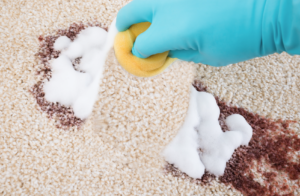

Disadvantages of Polypropylene Carpets
As great as these carpets can be, nothing in life is perfect. Before you make the decision to get yourself a polypropylene carpet, make sure you understand their weak spots as well as their advantages:
1) Polypropylene Is Sensitive To Heat
While the durability of polypropylene is generally high, they do have a weak spot when it comes to hot temperatures. Polypropylene carpets can degrade when constantly exposed to strong sunlight. This means they should be placed away from windows, especially if you live in an area with high temperatures. Direct sunlight can cause fading and weakening of the carpet fibres.
2) Susceptible to Oil-Based Stains
As stain resistant as polypropylene carpets are, they cannot handle oil stains too well. Dry cleaning the carpet will be your only option in this scenario, so make sure to keep any oils out of the room with these carpets if possible.
3) Low Resilience & Shape Retention
The resilience of polypropylene is not to be confused with its durability. Low resilience means that these carpers have difficulty retaining their initial shape, especially in high-traffic areas. While they are hard to tear, they are easy to flatten and squish which diminishes the look and feel of the carpet. Although polypropylene carpets have strong wear and tear resistance, the limited shape retention capabilities lowers the life span to around 7 years on average.
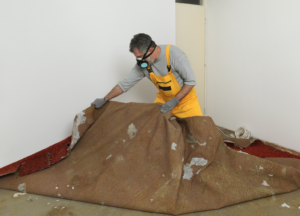

How Much Does Polypropylene Carpet Cost To Install?
Not only is polypropylene carpeting affordable to purchase but it is also cheap to install as well. You can expect a polypropylene carpet to cost anywhere from $35 to $60 per square metre for supply and installation, including carpet underlay in Sydney & NSW.
This makes them substantially cheaper to put down in your home compared to other synthetic counterparts and wool carpets.
We have an article dedicated to explaining the cost of supplying and installing all types of carpets.
Looking for a quote? Give us the room measurements and we’ll price you up! Feel free to contact us for a free consultation and quotation.
Direct Comparison of Synthetic Carpets
Polypropylene vs Polyester Carpet
Polypropylene and polyester fibres actually have a lot more in common than they do differences. Part of this is because they’re both made out of synthetic materials.
Both polyester and polypropylene are affordable, have great stain resistance, are very easy to clean and have good colour fade resistance as well.
Some of the newer polyester carpets are softer than polypropylene carpet, so if you are looking for something softer, then polyester might be the way to go.
Unfortunately, they both are oil absorbent and have low resilience. Though overall, polypropylene is less absorbent when it comes to all liquids so it is still the better choice for spills and messes.
Polypropylene vs Nylon Carpet
Polypropylene also has quite a few things in common with its nylon counterparts. Nylon is also a synthetic material, however it will be higher priced and has a fair share of benefits.
Both nylon and polypropylene fibres have strong durability, generate low static electricity, have great resistance to mold or mildew and are easy to clean and maintain.
Where they depart from each other is that nylon has better stain resistance and better resiliency, keeping a better appearance throughout the years. Nylon is typically more durable and longer lasting.
Keep in mind this is offset by the fact that nylon carpets can cost up to double the price of polypropylene carpet.
Polypropylene vs Wool Carpet
While blended styles exist, wool is primarily a natural fibre carpet so they have vastly different characteristics.
Wool carpets are considered highly soft and luxurious by any standard. They are also made out of renewable materials, are naturally flame-resistant, have excellent resiliency to wear and tear and is scientifically proven to regulate air quality and humidity.
On the other hand, wool carpets are more prone to mildew or mould growth if exposed to moisture and not cleaned on a regular basis. Furthermore, carpet beetles can attack the carpet as it uses wool as food.
They are basically the complete and total opposite of synthetic polypropylene carpeting. The only things that wool and polypropylene really have in common is that they don’t produce much static electricity and both are prone to discolour if exposed to direct sunlight in the long term.
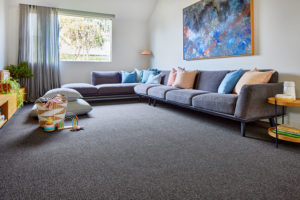

Conclusion – Should You Buy Polypropylene Carpet?
While polypropylene carpets aren’t perfect for every house, they may very well be perfect for yours. If you are looking to renovate on a budget then polypropylene is already looking like a safe bet. If you also want something stain resistant with dirt particles easily cleaned, then a polypropylene carpet is an ideal choice.
If you need any help or further advice on selecting the right carpet for your home, feel free to contact FloorVenue at any time. Whether you’re one of many homeowners curious about the carpet options at large or need specific consulting on different materials, we’re guaranteed to help you out.




























